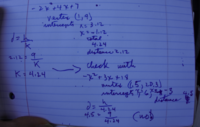There are lots of things to be said about both the assignment and their answer. I'll focus on what they told you to do; others may have more to say than you already have about "why they squared" in their solution method.
Their answer only shows the final algebraic work toward a final answer. They said to
explore for several
specific equations, but they didn't show that. You did that for one example, and seem to have just made a wild guess as to a possible relationship,
assuming a direct proportion. One case is not enough to determine a relationship; and you should never assume proportionality with out a reason. ("That's easiest" is not a valid reason.)
Let me show what I would do.
First, nothing said explicitly in the problem relates to the form of the equation (ax^2 + bx + c), so I'd disobey slightly and use the form that most directly relates to the question, namely what is sometimes called the "vertex form": y = a(x - h)^2 + k. In this form, what is "h" as they are using it (the y-coordinate of the vertex)? It's (unfortunately) what I called (traditionally) k. And what is their "d"? It's the distance from the axis, h, to either of the two intercepts, which are h + sqrt(-k/a) and h - sqrt(-k/a). The distance is sqrt(-k/a), right?
But let's back off, because we have to play with some specific equations. I'll just pick a few:
1: y = 1(x - 3)^2 - 4 --> h = -4, intercept is 3+2 = 5, and axis is 3, so d = 2
2: y = 2(x - 4)^2 - 6 --> h = -6, intercept is 4+sqrt(3), and axis is 4, so d = sqrt(3)
3: y = 3(x - 5)^2 - 9 --> h = -9, intercept is 5+sqrt(3), and axis is 5, so d = sqrt(3)
4: y = 4(x - 3)^2 - 4 --> h = -4, intercept is 3+1 = 4, and axis is 3, so d = 1
Since for the same h we can have different d (examples 1 and 4), and for the same d we can have different h (examples 2 and 3), clearly their claim that h and d themselves are related is false!
Something else also affects them. So they
could be proportional, but only when something else is fixed. We can't tell yet.
Let's try another example, where
a is the same as one of our original set:
5: y = 2(x - 4)^2 - 8 --> h = -8, intercept is 4+2 = 6, and axis is 4, so d = 2
Compared with example 2, we have multiplied h by 4/3, and multiplied d by 2/sqrt(3). So they aren't simply proportional, even with fixed a. But, look -- the ratio of h is the
square of the ratio of d! So
maybe h is proportional to the
square of d (for given a).
That's one way you might follow their instructions to eventually guess at a formula relating h to d; we would eventually find that the constant of proportionality is in fact -a, so our formula would be h = -ad^2.
That's a rather long and uncertain process. That's why they don't show it; they just show the algebraic way. But in fact, I accidentally found the relationship in talking about how we'd find d, because I started with the most convenient form! I said this: "the distance is sqrt(-k/a)". But in their terms, that says
d = sqrt(-h/a)
And that's the answer! We could leave it like that, or solve for h:
d^2 = -h/a
-ad^2 = h
So h is jointly proportional to a and to the square of d.
You asked,
Why doesn't the process of finding a coefficient of proportionality work here?
Do you see the answer? They are not directly proportional, so you can't assume that. You have to either do the experimentation and guess that it is a squared proportionality, or do the algebra and find out for sure.






